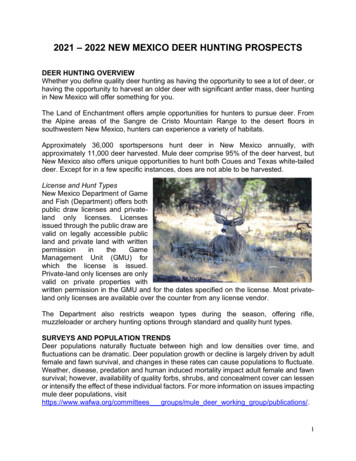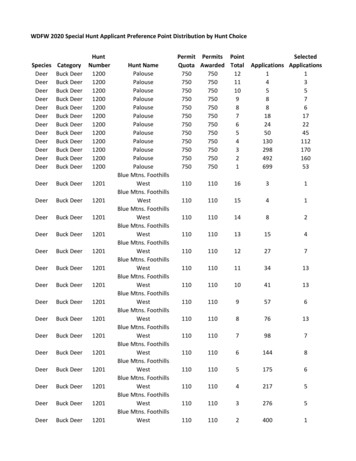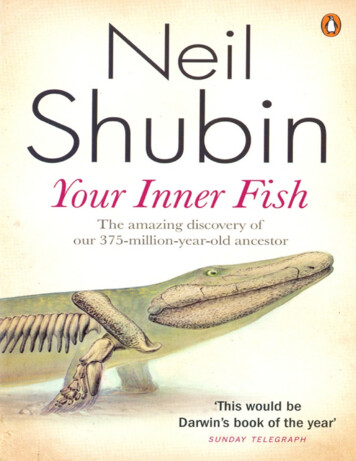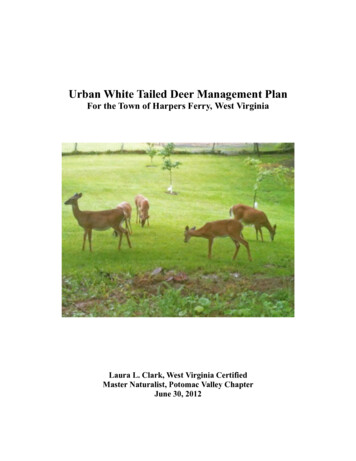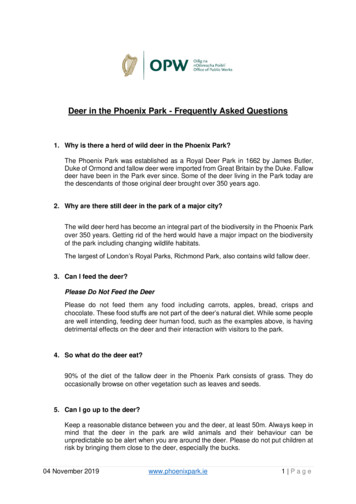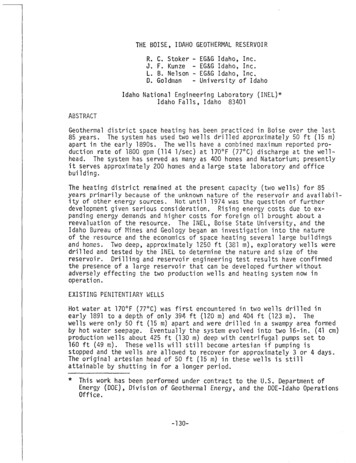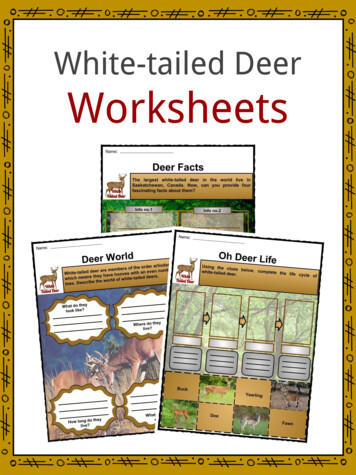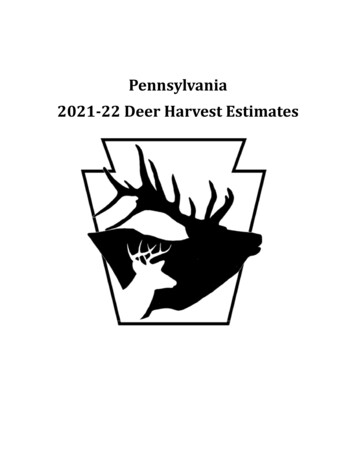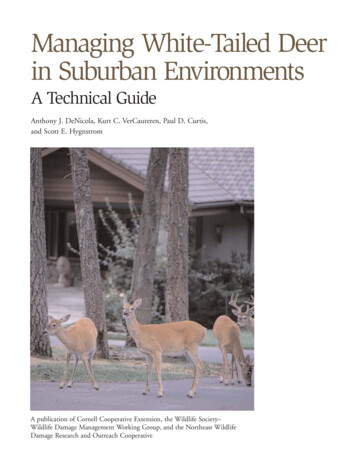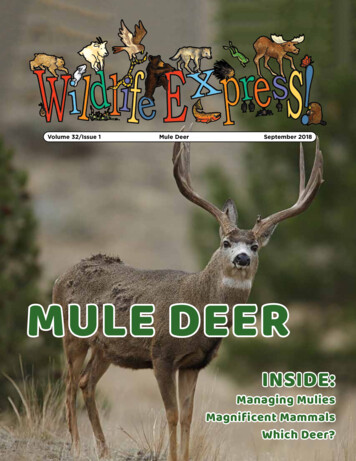
Transcription
Volume 32/Issue 1Mule DeerSeptember 2018MULE DEERINSIDE:Managing MuliesMagnificent MammalsWhich Deer?
areas next to waterways. Where you may findmule deer depends a lot on what time of year itis.MULE DEERWhat’s the most common large animalin Idaho? It jumps stiff-legged onall four legs to escape from danger.It’s the mule deer! The mule deer is one of twospecies of deer that live in Idaho. The other kindof deer is called the white-tailed deer.Scientists call the mule deer Odocoileushemionus (o-do-koy-LEE-us hem-EE-own-us).Hemionus means half-mule. By looking at themule deer’s ears, it is easy to see why it wasgiven this name. Mule deer have large ears thatlook a bit like mules’ ears. These large earshelp mule deer listen for sounds of danger likemountain lions and coyotes.Mule deer males are called bucks. Bucks averageabout 250 pounds. Bucks grow antlers. Thebetter the quality of food a buck eats thehealthier he will be and the larger his antlerswill grow. You cannot tell how old a buck is bythe size of his antlers. Females, called does, aresmaller. They average about 155 pounds. Muledeer babies are called fawns. Fawns are bornin May or June with a brown spotted coat. Thespots help the fawns hide in and around bushesand tall grasses. Fawns drink only their mother’smilk until they are about five weeks old. Thenthey start to nibble on plants. By the time theyare 16 weeks old, they are fully weaned and onlyeating plants.Mule deer are found in many different habitats,from high deserts to coastal forests. In Idaho,mule deer like rocky, brushy areas, openmeadows, pine forests, aspen tree groves andMule deer move, or migrate, to find food.During the summer and spring, mule deer maybe found on mountain slopes where shrubs,flowering plants and grasses grow. Does withfawns may be found around aspen tree groves.Aspen groves have many flowering plants, calledforbs. These plants are important for mule deer,especially nursing does, and the trees are greatshelter for the fawns. During the winter, deepsnow makes it harder for mule deer to get food.So, they move down out of the mountains intothe valleys and south-facing hillsides. Here snowis not as deep and food is easier to find. Muledeer may migrate 50 to 75 miles between theirsummer and winter homes. Sagebrush andbitterbrush are important mule deer food in thewinter.Mule deer like to eat the soft tips of shrubs andbushes. Shrubs are high in protein and have thenutrients mule deer need. Mule deer will also eatsoft plants and some grasses. Grasses make upthe smallest part of their diet. Grasses do nothave as much nutrition and are harder for muledeer to digest.The most important habitat for mule deer isthe summer habitat. If deer eat well during thesummer and are nice and fat when winter comes,they usually can survive cold harsh winters. Butif mule deer cannot find good nutritious foodin the summer, no matter how good the winterhabitat may be, mule deer will have a hard timesurviving the winter.Keep an eye out for mule deer next time youare out in Idaho’s wild places. They are beautifuldeer and lots of fun to watch, especially whenthey are bouncing away from danger. Mule deercan jump over a four-foot fence!
MANAGING MULIES Nicholas D. CC BY-NC-ND 2.0, FlickrOver the years, the number of mule deerin some parts of Idaho has been goingdown. Mule deer numbers have notjust been getting lower in Idaho. Mule deer aregetting harder to find in every state in the west.Why is this happening, and how can Fish andGame help?Fish and Game can use hunting seasons tomanage mule deer. If the population of muledeer is high, managers can let hunters harvestmore deer. If populations are low, managers maynot let hunters harvest does or fawns. They mayalso shorten hunting seasons. This may helpincrease the population in the future.Many things affect mule deer. Habitat, predators,hunting, weather, climate, and humans all playa role. Fish and Game has no control over somethings, but they can influence habitat, predators,hunting and some human activities.To get an idea of the number of mule deer, Fishand Game goes up in the air. How would you liketo buzz over a herd of mule deer in a helicopter?Fish and Game can’t fly over the whole state,so they pick important wintering grounds to flyover. Deer are grouped together in the winter, sothis is the time to count. It is also easier to seebrown deer in white snow. While flying over thedeer in a helicopter or plane, people count allthe deer they can see.Mule deer habitat has been changing fromshrubs, aspen trees and soft plants to habitatswith more grasses and pine trees. Cheatgrassis one grass that has been spreading across thewest. It came to our country in the 1800s andhas been doing well ever since. Cheatgrass is notgood food for mule deer and other wildlife. Toimprove mule deer habitat, Fish and Game workswith landowners to plant bitterbrush, sagebrushand other shrubs mule deer eat. The aspen treesdoes and fawns need are also declining. Fish andGame is working with people to help restore thisvital part of habitat.Biologists also look at predators. Coyotes willeat mule deer fawns, and mountain lions eatboth the fawns and adults. Biologists found thatpredators do play a role in the amount of muledeer in an area, but it is a small role. Just howmuch predators affect mule deer depends uponthe habitat, weather and time of year. Removingpredators from an area may help under certainconditions, but it costs a lot of money.Fish and Game also puts radio collars on fawns.The collars are used to see how many fawnssurvive the winter. If many fawns survive thewinter, managers know mule deer populationsare doing well. If fewer fawns survive, managersmay need to take steps to help the population.Many things may make mule deer numbersdecrease. It will take time, money and patienceto increase the number of mule deer living inIdaho, but Fish and Game is up to the challenge. Ron Stewart CC BY-NC-ND 2.0, Flickr
Phil McIver CC BY-NC-ND 2.0, Flickr Jon Gittenberg CC BY-NC-ND 2.0, Flickr Neil McIntosh CC BY-NC-ND 2.0, FlickrDeer Family David McKelvey CC BY-NC-ND 2.0, FlickrThe Dan Dzurisin CC BY-NC-ND 2.0, FlickrThroughout the world there are about 40different species (kinds) of deer. Theyare found on every continent exceptAntarctica and Australia. Africa has only onenative deer, the red deer.Deer come in many sizes. The smallest deerin the world lives in the Andes Mountains. Thepudu stands about one foot tall and weighs lessthan 20 pounds. The biggest deer in the world isthe North American moose. A male moose canweigh up to around 1,300 pounds!One thing all deer have in common is that theyare ungulates (UN-gyu-lits). All ungulates havehooves. They are also herbivores; they eatplants. Grasses, leaves and twigs are tough toeat. To help them digest plants, ungulates havestomachs divided into four different chambers orrooms. They nip off plants, but they don’t chewtheir food much before swallowing it. The plantsgo into the first chamber of the stomach. It isfull of bacteria and other organisms that helpbreak down the plants. Later, deer spit up thefood and chew it again. Have you ever heard ofcows chewing their cud? They are chewing foodregurgitated from their stomachs. Once chewed,the food is swallowed again and passes into the Thomas J. Caldwell CC BY-NC-ND 2.0, Flickrsecond and third parts of the stomach wherewater is taken out. The fourth chamber is theone that is most like your stomach. It absorbsthe nutrients out of the food.Having a stomach with many chambers not onlyallows deer to eat tough plants, it also helps tokeep them safe. Many animals are at risk whenthey eat. Predators are more likely to see a deereating in a clearing than hiding under a tree, sodeer eat quickly. They nip off plants, chew themjust a little and then swallow them. Once theirfirst stomach is full, deer find a place to rest andhide. Now deer can fully chew and digest theirfood, without having to constantly look out fordanger.Members of the deer family in North Americainclude elk, moose, caribou, mule deer andwhite-tailed deer. Wherever you live in NorthAmerica, you are likely to be near at least onemember of the deer family. Idaho, however, islucky. We have all five species living in our state!
MagnificentMammals Michelle Kemner FOR IDAHOFISHANDGAMEMule deer are mammals. Their bodiesare covered with hair. They are warmblooded, and they feed their youngmilk. Worldwide there are about 4,000 differentspecies of mammals. They are found everywhereon Earth. The largest mammal is the bluewhale. It can weigh up to 196 tons! The smallestmammals are the shrews which weigh about asmuch as three paper clips and the bumblebeebat which weighs as much as a penny.Mammals are warm-blooded. The temperatureinside their bodies stays about the same allthe time. This allows mammals to live in a widevariety of places. Snakes are cold-blooded. Theirbody temperatures are always the same as theirsurroundings. Humans have a body temperaturethat is usually about 98.6 degrees Fahrenheit.Does this make you warm-blooded or coldblooded?Many mammals live on land, but not all of them.Whales, porpoises and manatees spend theirwhole lives in water. After their young are born,the mothers help their babies to the top of thewater to take their first breath. Seals, sea lionsand walruses spend most of their time in thewater, but they leave the water to breed, givebirth and rest. NOAA/NMFS NOAA News CC BY-NC-ND 2.0, Flickr NRCA CC BY-NC-ND 2.0, FlickrSome mammals lay eggs! Have you ever heardof a duck-billed platypus or echidna (a-KID-na)?They are found in Australia. These mammalsdon’t give birth to live young. The young hatchout of eggs, but they still drink their mothers’milk. Drinking mother’s milk is one thing thatsets mammals apart from all other animals.Mother’s milk is the perfect food for a youngmammal. It is full of vitamins, minerals and lotsof fat. Fat helps babies grow quickly. Seal andwhale milk is half fat! That’s 50%.Whole milkyou may drink from cows has 4% fat. Sealsand whales need a layer of fat, called blubber,to insulate them from the cold ocean water.The high fat content of their mothers’ milkhelps ocean mammals build up a nice layer ofblubber to keep warm. Fat is also important tohelp mammals brains grow. Mammals have thelargest, most developed brains compared toother kinds of animals.Mammals are all around us. To see a mammal allyou have to do is look in the mirror. You are amammal, too! Nik Borrow CC BY-NC-ND 2.0, Flickr
AWES OMEANTLERSAntlers grow on members of the deer family.They are bones that grow out of the animal’sskull. An antler grows faster than any otherkind of bone. It can grow up to one inch a day duringthe summer! Usually only the males grow antlers,but female caribou can grow antlers. There is evena species of deer where neither the male nor femalegrow antlers – the Chinese water deer.Antlersare lightand easilydamaged untillate summer. Atthis time, they arecovered with a thinskin called velvet.Velvet is coveredwith fine, short hairsand contains thousandsof blood vessels. The bloodvessels carry calcium and mineralsneeded for building strong bones. Ifa mule deer damages his antlers badlyat this point, he could actually bleedto death! Deer don’t do much as theirantlers are growing; they stay hidden andare not aggressive. Once the antlers havegrown, the blood vessels in the velvet closeoff. The velvet dries up and starts to fall off.By October or September, the velvet hasbeen completely rubbed off, and the antlersare hard and polished - ready to show off forthe females and intimidate younger males.Deer shed their antlers in early winter and thenimmediately begin to grow another set. Then theprocess starts all over again!
Which Deer?Idaho has two different kinds of deer – white-tailed deer and mule deer. You need to be able to tellthese two deer apart, especially if your family hunts. The way to tell them apart is as easy as aSTARE – Startled movement, Tail, Antlers, Rump, and Ears.White-tailed Deer:Mule Deer: W hen startled, jump away on all four legs,called a “pronk” or “stott” Skinny, white tail with black tip Antlers branch equally, separate beamsfork into two tines forming a “V” White rump Large mule-like ears W hen startled, raise tail and showwhite “flag” F lat, brown tail with white fringe andwhite underside A ntlers have tines all coming from largemain beam Brown rump Small ears Brian Henderson CC BY-NC-ND 2.0, Flickr Dawn Huczek CC BY-NC-ND 2.0, Flickr Larry Smith CC BY-NC-ND 2.0, Flickr Tony Takes CC BY-NC-ND 2.0, Flickr Bill Bates CC BY-NC-ND 2.0, Flickr Kevin Smith CC BY-NC-ND 2.0, Flickr Lee McDowell CC BY-NC-ND 2.0, Flickr Dwayne Ewers CC BY-NC-ND 2.0, Flickr Clinton-CharlesRobertsCC BY-NC-ND 2.0, Flickr Austin Young CC BY-NC-ND 2.0, Flickr
Glenn Oakley FOR IDAHOFISHANDGAMEBe Outside it’s hunting seasonFall brings with it cooler weather, colorfulleaves, and hunting season. For hunters,fall is their favorite season. While they allhope to harvest an animal, hunters also enjoythe other benefits of hunting: spending timeoutdoors with family and friends and watchingwildlife.If you are interested in hunting, a first step isHunter Education. This class is required if youwant to get a hunting license. You can takehunter education when you turn nine. The classwill introduce you to many important thingssuch as firearm safety, hunter responsibility, andwildlife conservation. These topics will help youlearn to be a safe, responsible hunter. You willalso learn how hunting is important to wildlifemanagement, and the important role huntershave played in wildlife conservation in the UnitedStates.learn a lot from other hunters. Help look foranimals by finding tracks and scat or scanningwith binoculars. Bring a backpack to help carryequipment. Help find your way using a mapand compass. If an animal is harvested, helpfield dress the animal and pack it back to yourcamp. You can even learn to cook what has beenharvested. All these experiences along withhunter education will help prepare you for yourfirst hunt.If you are interestedin hunting, a first stepis Hunter Education.You can also learn about hunting by going onhunting trips with family members or friends.Even if you are not ready to hunt, you can Glenn Oakley FOR IDAHOFISHANDGAME
Mule Deer CrosswordWORDSAcross3. Mule deer has been changing.4. These tree groves are important for does and fawns.6. Mule deer don't eat much .8. Deer to find food in the winter.9. This is an important food for mule deer in the tingMigrateSummerUngulatesDown1. Deer are .2. Mule deer were named for their .3. Fish and Game can use seasons to manage mule deer.5. They are predators on mule deer fawns.7. The most important habitat for deer is the habitat.WILDLIFE EXPRESSVolume 32 Issue 1 Mule Deer September 2018Wildlife Express is published nine times a year(September-May)by the Idaho Department of Fish and GameLead Writer: Adare EvansLayout: Glenna GomezContributors: Adare Evans, Vicky RunnoeWE WOULD LIKE TO HEAR FROM YOU!If you have a letter, poem or question for Wildlife Express,it may be included in a future issue! Send it to:adare.evans@idfg.idaho.govorWildlife Express, Idaho Fish and GamePO Box 25, Boise, ID 83707
Mule deer like to eat the soft tips of shrubs and bushes. Shrubs are high in protein and have the nutrients mule deer need. Mule deer will also eat soft plants and some grasses. Grasses make up the smallest part of their diet. Grasses do not have as much nutrition and are harder for mule deer to digest. The most important habitat for mule deer is
